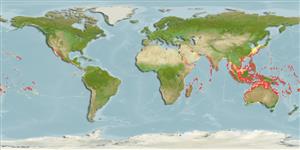Common names from other countries
Environment: milieu / climate zone / depth range / distribution range
Écologie
; profondeur 0 - 100 m (Ref. 348), usually 0 - 5 m (Ref. 348). Tropical
Distribution
Pays | Zones FAO | Écosystèmes | Occurrences | Introductions
Indo-Pacific: from East Africa, to eastern Polynesia; north to Japan and south to Queensland and New Caledonia.
Length at first maturity / Taille / Poids / Âge
Maturity: Lm ? range ? - ? cm Max length : 11.0 cm SHL mâle / non sexé; (Ref. 348); common length : 8.5 cm mâle / non sexé; (Ref. 348)
Maximum depth from Ref. 101147. Attached by its byssus to coral slabs, rubble under the slab (Ref. 101147), under coral heads and rocks (Ref. 348). Frequently encrusted by sponges, bryozoans, algae, and other marine growths. Able to swim actively for some distance when detached. Common in the intertidal and shallow subtidal zones (Ref. 348). Also occurs on rubble, soft sediments, and scattered reefs (Ref. 87907). At night, adults seem to move to open water to feed and return to rubble pile in the day (Ref. 101147).
Life cycle and mating behavior
Maturité | Reproduction | Frai | Œufs | Fécondité | Larves
Members of the class Bivalvia are mostly gonochoric, some are protandric hermaphrodites. Life cycle: Embryos develop into free-swimming trocophore larvae, succeeded by the bivalve veliger, resembling a miniature clam.
Poutiers, J.M. 1998. (Ref. 348)
Statut dans la liste rouge de l'IUCN (Ref. 130435)
statut CITES (Ref. 108899)
Not Evaluated
Not Evaluated
Menace pour l'homme
Harmless
Utilisations par l'homme
| FishSource |
Outils
Plus d'informations
Taille/Âge
Croissance
Longueur-poids
Longueur-longueur
Morphologie
Larves
Abondance
Sources Internet
Estimates based on models
Preferred temperature
(Ref.
115969): 24.6 - 29.2, mean 28.3 (based on 3624 cells).
Vulnérabilité
Low vulnerability (10 of 100).
